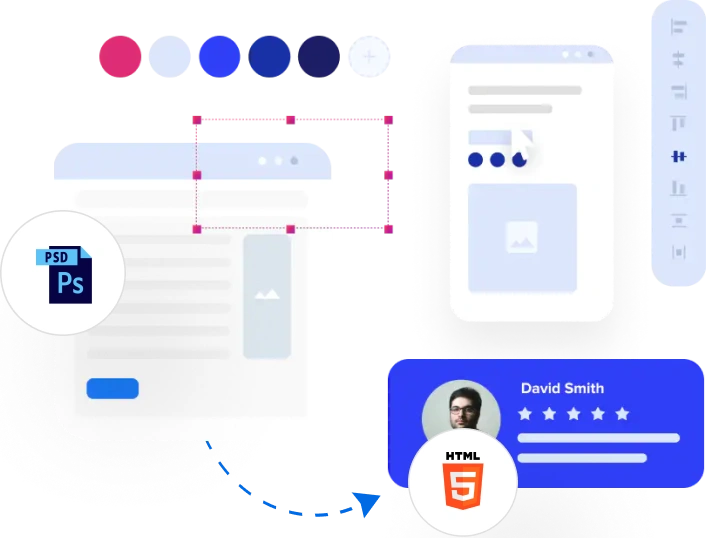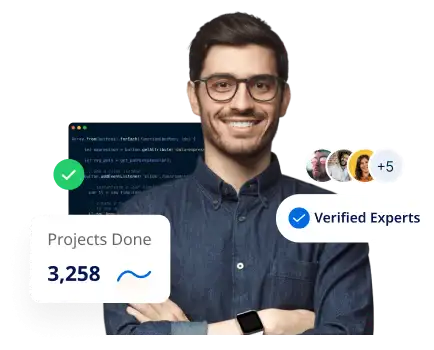
Bring your static PSD designs to life with modern frameworks built for scalability, speed, and clean architecture.
Convert your PSD designs into responsive, grid-based Bootstrap 5 layouts that adapt perfectly to every device.
Transform your PSD designs into lightweight, utility-first Tailwind CSS code that’s fast, flexible, and scalable.
Turn your PSD designs into dynamic React applications powered by modular, component-based architecture.
Convert your PSD files into enterprise-grade Angular applications with a strong focus on structure, reusability, and maintainability.
Our team transforms your PSD designs into interactive Vue.js front-ends that are flexible, fast, and easy to scale
For businesses looking for performance and SEO advantage, we also convert PSD designs into Next.js (React) frameworks.
Get modern, pixel-perfect HTML code that refreshes your online presence and keeps users engaged on all devices.

Our experts transform your PSD designs into responsive, search-friendly, and W3C-validated HTML websites – ensuring precision, scalability, and performance.

We convert PSDs into clean, semantic HTML5/CSS3 code optimized for speed and compatibility across devices.
We build lightweight, search-optimized HTML with proper hierarchy, fast load times, and structured metadata for better rankings.
We implement modular, reusable styling systems for easy maintenance and faster future updates.
Get tailored HTML templates designed to reflect your brand and business needs – ready for CMS or integration.
Every deliverable undergoes rigorous validation and testing to ensure compliance, accessibility, and cross-browser support.
PixelCrayons has helped 100+ agencies convert PSD to HTML, providing fast, responsive, and websites that are optimized for search engines.
Small and mid-sized agencies often need fast and reliable PSD to HTML conversion. With responsive design and search-friendly websites, these agencies can offer top-tier websites to their clients, increasing efficiency and client satisfaction.

Large agencies require PSD to HTML services that can handle complex designs and large volumes. PixelCrayons delivers scalable, robust, and cross-browser-compatible solutions. Converting PSD to HTML efficiently means faster project delivery, allowing agencies to manage multiple clients without compromising quality.

PSD to HTML conversion services can help agencies create responsive and SEO-friendly websites in less time and without the need to hire an in-house expert. This way, agencies can grow the online presence of their clients, drive more traffic, and increase conversions.

No matter your business size or needs, PixelCrayons can help. With PSD to HTML services, we can create impressive and fully functional websites with great features.
We convert PSD files to formats like WordPress, Drupal, Magento, and Joomla that work on all browsers.

We transform your outdated PSD designs into sleek, modern HTML pages that leave a lasting impression on users.
Be it PSD to Bootstrap conversion, PSD to Tailwind conversion or any other PSD to HTML conversion service, having a clearer understanding of how this will deliver better ROI, always helps. Here’s an insight to help you learn more about the challenges, benefits, and more.
![]()
PSD to HTML conversion has many benefits for businesses. It improves the functionality, accessibility, and user experience of the website.
1. Improved Website Performance
2. Mobile-Friendly Websites
3. Improved SEO Performance
4. Scalability and Flexibility
5. Better User Experience
6. Reduced Development Time
![]()
A well-converted website must include key features to ensure functionality, performance, and usability. Here are some essential features:
1. Responsive Design
2. Cross-Browser Compatibility
3. Clean and Structured Code
4. SEO
5. Interactive and Engaging Features
6. W3C Validation
![]()
PSD to HTML conversion is not a simple process. Here are the common problems and ways to solve them.
1. Maintaining Design Consistency
One of the biggest challenges in converting PSD to HTML is matching the original PSD design in terms of layout, colors, fonts, and spacing.
2. Cross-Browser Compatibility
Your website might display differently on different browsers. It is important to make sure the site looks great on Chrome, Firefox, and Safari.
3. Responsive Design for All Devices
The number of mobile searches is increasing; therefore, businesses have to make sure that their website performs well and looks good on any screen size. Ensuring responsiveness can be difficult.
4. Complex Interactivity and Animations
Including complex features like sliders, hover effects, or animations can complicate the conversion.
5. SEO
HTML must be well-structured for search engines to crawl and rank the website properly. Poor HTML structure can affect your SEO rankings.
Solving these challenges helps businesses get smooth, functional PSD to HTML conversions. The results are visually appealing and fit their needs.
| Aspect | PSD to HTML Conversion | PSD to Webflow Conversion |
| Coding Requirement | Requires manual coding and technical skills in HTML, CSS, and JavaScript. | No coding required, Webflow’s visual interface handles the design and coding. |
| Design Flexibility | Offers full control over the design with custom code. | Limited to Webflow’s design tools, but allows easy drag-and-drop customization. |
| Responsive Design | Responsive designs require manual setup using CSS media queries. | Webflow automatically generates responsive designs for various devices. |
| Ease of Use | Requires developers with PSD to HTML conversion expertise. | Very user-friendly for non-technical users to make changes. |
| SEO | SEO must be manually optimized during the conversion. | Webflow offers built-in SEO features like auto-optimization for tags. |
| Time to Complete | Generally takes longer due to the manual coding process. | Faster as Webflow simplifies the process through visual design tools. |
| Customization Options | Allows complete freedom for advanced customization. | Limited by Webflow’s constraints, though highly flexible within the platform. |
| Hosting and Maintenance | You’ll need to arrange hosting and maintenance separately. | Webflow provides built-in hosting, maintenance, and support. |
| Scalability | Highly scalable with the right development expertise. | Limited scalability depending on Webflow’s platform features. |
| Cost | It can be cost-effective depending on the complexity. | Webflow may have subscription costs, but no need for developers. |
Both options have pros and cons. Choose the one that best meets your goals and technical resources. If a business needs full control over code and custom features, it is better to go for PSD to HTML conversion.
If ease of use and speed are priorities, PSD to Webflow could be the way to go.
1. Adobe Photoshop
Adobe Photoshop is the starting point for converting your design into a website. It lets designers create high-quality designs. These designs can be sliced and exported for conversion into HTML.
2. Sublime Text / Visual Studio Code
These text editors are essential for writing clean and semantic HTML code. They offer features like syntax highlighting and code completion. It makes writing and debugging your code easier.
3. Bootstrap
Bootstrap is a popular front-end framework for responsive websites. It helps you create flexible layouts with ready-made components. It reduces development time when converting PSD to HTML.
4. Sass / LESS
Sass and LESS are CSS pre-processors that simplify writing complex stylesheets. These tools help convert PSD to HTML faster by organizing CSS and offering features such as variables, nesting, and mixins.
5. Gulp / Webpack
Gulp and Webpack are task runners that automate the development process. These tools help with tasks like image compression, file minification, and live browser refresh during conversion.
![]()
Here are the key factors to consider when choosing a PSD to HTML conversion service provider:
1. Experience and Expertise
Look for a provider with a great record in PSD to HTML conversion. They should have experience with various projects, from simple landing pages to complex, multi-page websites.
2. Quality of Code
The quality of the HTML code is important for the performance and scalability of the website. Make sure the conversion service provider designs a clean, well-structured, and semantic code following the best practices:
3. Turnaround Time
Speed matters, especially when deadlines are tight. Pick a service provider who can deliver fast without cutting corners on quality.
4. Customer Support and Communication
A provider must be responsive and transparent in their communication, keeping you updated at every stage of the conversion process.
5. Cost vs. Value
Cost is an essential criterion, but don’t make it the only consideration. The cheapest provider may not always offer the best quality. There should be a good balance between the cost and quality.
Have questions related to PSD to HTML conversion services that PixelCrayons offers? We are here to help.
Outsourcing your PSD to HTML conversion project to PixelCrayons provides many benefits, such as:
It can take up to 7 business days, but there are other factors that can impact delivery time.
At PixelCrayons, we use the latest technologies and tools to convert PSD to HTML:
PixelCrayons has a large, skilled team of over 450 developers who specialize in various aspects of PSD to HTML conversion services.
Our team is equipped to handle projects of all sizes and complexities, ensuring top-notch quality and fast delivery.
Yes, we can handle PSD to HTML conversions for both simple and complex designs.
Whether it’s a one-page website or a multi-page, interactive platform, we provide high-quality PSD to HTML services tailored to your needs.
To maintain high standards in PSD to HTML conversion, we follow a strict process:
The cost of PSD to HTML conversion varies depending on factors like:
To get an accurate quote, please contact us with your project details, and we’ll provide a custom estimate based on your needs.
Let us show you how our digital services can drive your success.